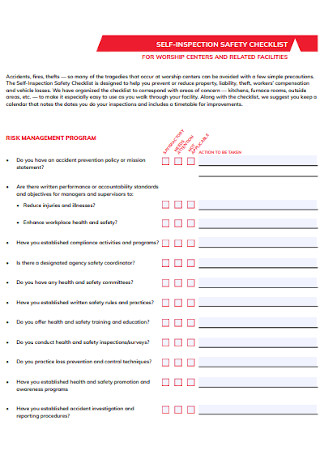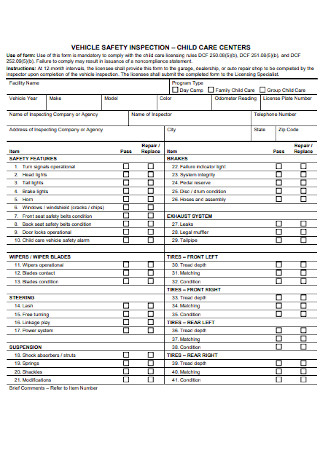11+ Sample Vehicle Safety Inspection Checklists
-

Weekly Vehicle Safety Inspection Checklist
download now -

Vehicle Safety Inspection Checklist Template
download now -

Utility Cart Safety Inspection Checklist
download now -

Monthly Vehicle Safety Inspection Checklist
download now -

Annual Vehicle Safety Inspection Checklist
download now -

Vehicle Service Safety Inspection Checklist
download now -

Heavy Vehicle Safety Inspection Checklist
download now -

Vehicle Self-Safety Inspection Checklist
download now -

Vehicle Safety Inspection Checklist Example
download now -

Simple Vehicle Safety Inspection Checklist
download now -

Sample Vehicle Safety Inspection Checklist
download now -

Sample Vehicle Safety Inspection Checklist
download now
FREE Vehicle Safety Inspection Checklist s to Download
11+ Sample Vehicle Safety Inspection Checklists
What Is a Vehicle Safety Inspection Checklist?
What Is Included in a Vehicle Safety Inspection Checklist?
How to Create a Vehicle Safety Inspection Checklist
FAQs
What is the benefit of having my vehicle inspected?
How often should I get my vehicle inspected?
How much does a vehicle safety inspection cost?
What happens if I fail my vehicle inspection?
What is the difference between vehicle inspection and emissions inspection?
What are the types of Vehicle Safety Inspections?
What Is a Vehicle Safety Inspection Checklist?
Whenever the inspector or mechanic inspects your motor vehicle, you can usually see them going through an inspection checklist. A Vehicle Safety Inspection Checklist is used by an authorized mechanic at a vehicle inspection center to serve as a guide whenever they check your vehicle for issues. This makes the job easier for them, as they already know what parts of the vehicle that they need to inspect for defects or significant damage. When done properly, this saves the owner money in the long run, and will save them from sudden troubles that could suddenly happen on the road. The checklists usually include the vehicle’s make and model, and the year it was manufactured. However, the actual components to be inspected depend on the vehicle. For example, a forklift inspection checklist greatly differs from that of a small motorcycle vehicle inspection checklist.
What Is Included in a Vehicle Safety Inspection Checklist?
Getting your vehicle inspected thoroughly can have a positive long-term benefit on the owner because it saves you time and money that you would have used for buying expensive replacement vehicle parts if you don’t notice them begin to wear out and eventually fail. Here are the most common things that are included in a vehicle inspection checklist:
How to Create a Vehicle Safety Inspection Checklist
A Vehicle Safety Inspection Checklist is essential for any vehicle inspection center as it makes the usually rigorous and complicated task easier, less confusing, and more streamlined.
1. Familiarize the vehicle to be inspected.
As the vehicle arrives at the inspection center, it is important that the inspector familiarizes the vehicle, so as to avoid any unnecessary confusion when conducting the check itself. The inspector should identify the following details (but not limited to): the purchased vehicle type, its make and model, and the year the vehicle was manufactured.
2. Creation of the Checklist
Once the familiarization process of the vehicle is done, it is time to create the checklist. It can be written by hand or digitally encoded, depending on the preference of the inspector. Here, the items necessary in the checklist are included, such as the vehicle and owner’s information, the parts and components to be inspected, as well as anything that is unique to that specific vehicle model. The inspector also usually leaves space for feedback and recommendations. Depending on the inspector’s preference he/she can also turn it into a questionnaire checklist.
3. Verify the checklist.
When the creation of the checklist is done, make sure to verify it with the information that is researched, to make sure that it is correct and nothing of importance is overlooked. It is also important to let the vehicle owner know about the items that you have included in the inspection checklist, to avoid any confusion.
4. Perform the vehicle safety inspection.
Once both parties are satisfied with the checklist created, then the inspection process itself can begin. Begin by having the vehicle owner fill out his/her information, then proceed with checking the vehicle’s components, with respect to the checklist that you have created. This process can take a while, depending on the vehicle, and the number of components to be tested and inspected. Once the process is complete, the inspector then begins the evaluation process, as he/she writes his/her feedback and recommendations in the checklist, or communicates it directly to the owner of the vehicle.
FAQs
What is the benefit of having my vehicle inspected?
You save costs in the long run, and it also extends the vehicle’s service life. Inspections also reduce the costs of repair and replacement, hereby maximizing your vehicle’s value. It also prevents small defects that are detected during the inspection from evolving into much bigger ones. Having a proper assessment of the vehicle can also save the owner from the eyes of law enforcement, as it ensures that the vehicle complies with the safety and emission standards that the place regulates. Most importantly, having the vehicle inspected frequently will grant the owner peace of mind, as he/she will not expect a failure to suddenly happen while out on the road.
How often should I get my vehicle inspected?
This depends on how frequently you use your vehicle. But it is generally recommended that you get your vehicle routinely inspected during every oil change visit. It can be within 3 to 6 months, and it can also be every 10000 kilometers traveled, whichever comes first. However, should you notice any irregularities in your vehicle while driving it between intervals, it is also best to take it to the shops immediately for an inspection and possible repair, to minimize the damage and the costs that can accumulate if you neglect any signs of problems that appear.
How much does a vehicle safety inspection cost?
The cost of getting your vehicle inspected totally depends on the place you live, and the type of the inspection performed, whether it is routine, or component-specific. It also depends on the type of vehicle, as small cars and motorcycles have fewer components than a trailer truck, and thus is much cheaper to inspect. Commercial vehicles (vehicles used to ferry goods or passengers) also have significantly higher inspection costs than non-commercial vehicles.
What happens if I fail my vehicle inspection?
In most places, the inspectors will usually place a “failed inspection” sticker on your vehicle. You are then given time to repair the vehicle and get it reinspected. The inspector also gives a detailed report on the components of the vehicle that caused it to fail the inspection. Should you decide to become a hooligan and drive the vehicle with the “failed inspection” sticker on it, you can get flagged down by law enforcement for driving a vehicle with components out of compliance.
What is the difference between vehicle inspection and emissions inspection?
Vehicle inspection examines the different parts of the vehicle, such as brakes, tires, lights, doors, and windows. This is done to ensure that the vehicle has proper working parts to provide the owner a safe mode of transportation. Emissions Inspection covers the fuel and exhaust systems to make sure that the vehicle is not producing too many emissions due to malfunctioning parts, and to make sure the vehicle meets the current emissions standards of the place it is traveling. Too many emissions can be detrimental to the environment and should be regulated as time goes on.
What are the types of Vehicle Safety Inspections?
It depends on the inspection center that is performing the checks. But the most common types are the following:
1. Courtesy Inspection. This type of inspection comprises the components of the vehicle that are easily seen, such as the lights, windows, and wipers. This is usually performed during the vehicle’s routine service intervals such as an oil change or tire replacement.
2. Insurance Inspection. This type of inspection is generally required and performed on vehicles that will turn 10 years old at the time of the inspection so that they can be properly insured. This is done to properly assess the risks of the vehicle while it is being driven on the road.
3. 12-point Inspection. This type of inspection is the most thorough. In a 12-point inspection, the things that are being checked are the following: Fluid levels, Tire rotation and balance, Tire wear, Wheel condition, Wiper blades, Belts and hoses, Lights, Suspension components, Brake System, Battery Charge, Timing Belts, and the Cabin Air Filter.
When done properly, having a Vehicle Safety Inspection Checklist can give both the inspector and the vehicle owner the assurance that each component has been thoroughly inspected. As each part or component is being ticked off, the inspector is verifying that it is in good condition and is in optimum working order. If you can, ask the inspector to give you a copy of the checklist, as it ensures that any issues can be predicted easier and also enables you to have a full comprehensive history of the inspections and the services that the vehicle underwent. The checklist also serves as an important document should you decide to sell your vehicle in the future. If you find it difficult to create your own checklist, there are examples provided above that you can download and will serve as a guide to making an inspection checklist of your own in the future.
